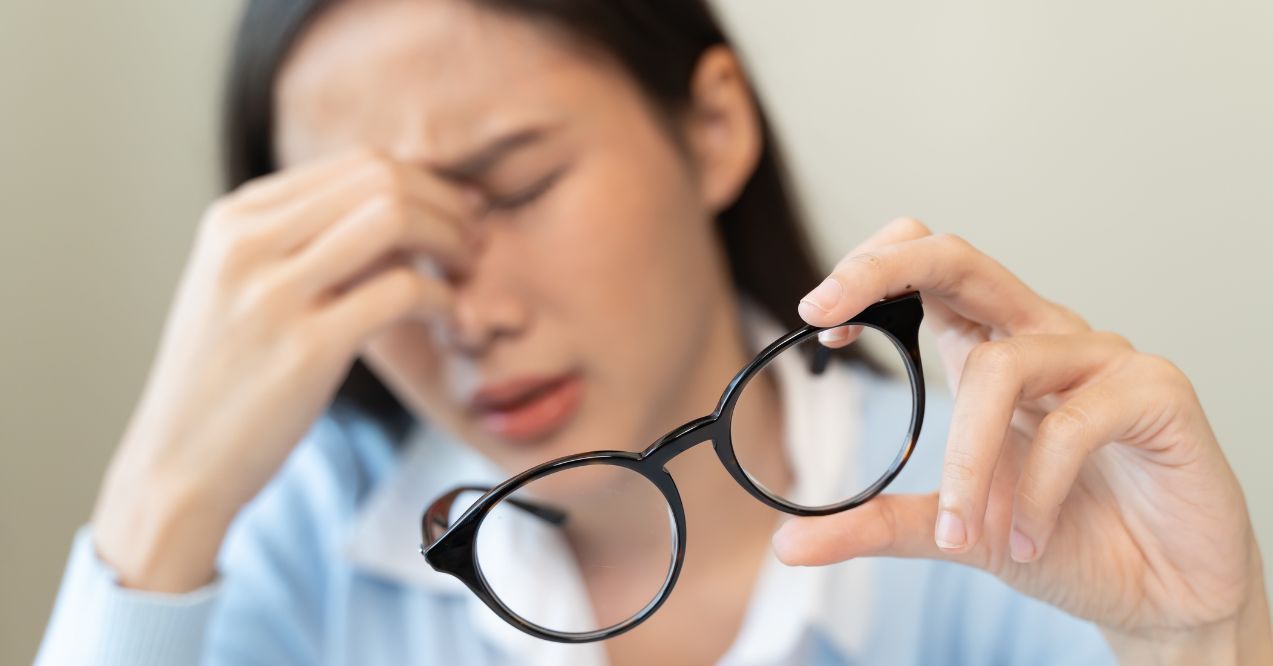Why Is My Eyesight Getting Worse? 6 Possible Reasons
Medically reviewed by our experts


You’ve noticed your vision is blurrier than before. Fine print that you once read easily now requires squinting. Street signs appear fuzzy until you get closer.
Why is my eyesight getting worse when nothing else seems wrong? Many people assume age alone causes these changes. However, six distinct structural and lifestyle factors may contribute to sight deterioration. This article explains each reason in plain terms and offers safe supportive strategies.
How Eyesight Changes Over Time
Your eye’s lens loses flexibility gradually over decades. The tiny muscles controlling pupil size weaken slowly. Corneal shape may shift slightly as tissue composition changes.
These structural shifts represent cumulative wear rather than disease:
- Light passes through your eye and bends at specific angles
- When structures change even slightly, those angles shift too
- The result is a gradual drift in visual clarity
This happens to most people and follows predictable patterns. Your eyes are simply responding to decades of constant use. It’s common to wonder, does your eyesight improve with age? Generally, natural aging makes vision less flexible, but supportive habits can help maintain clarity and comfort longer.
Why Is My Eyesight Possibly Getting Worse?
Sudden vision changes can be concerning, but most shifts in clarity result from normal aging and daily habits rather than serious problems. Your eye structure, function, and everyday strain all play a role.
Understanding common factors for gradual vision decline helps you make informed decisions about eye care — especially if you’ve been asking, why is my vision getting worse even with healthy routines. The following sections outline these causes clearly.
Reason 1: Refractive Shift
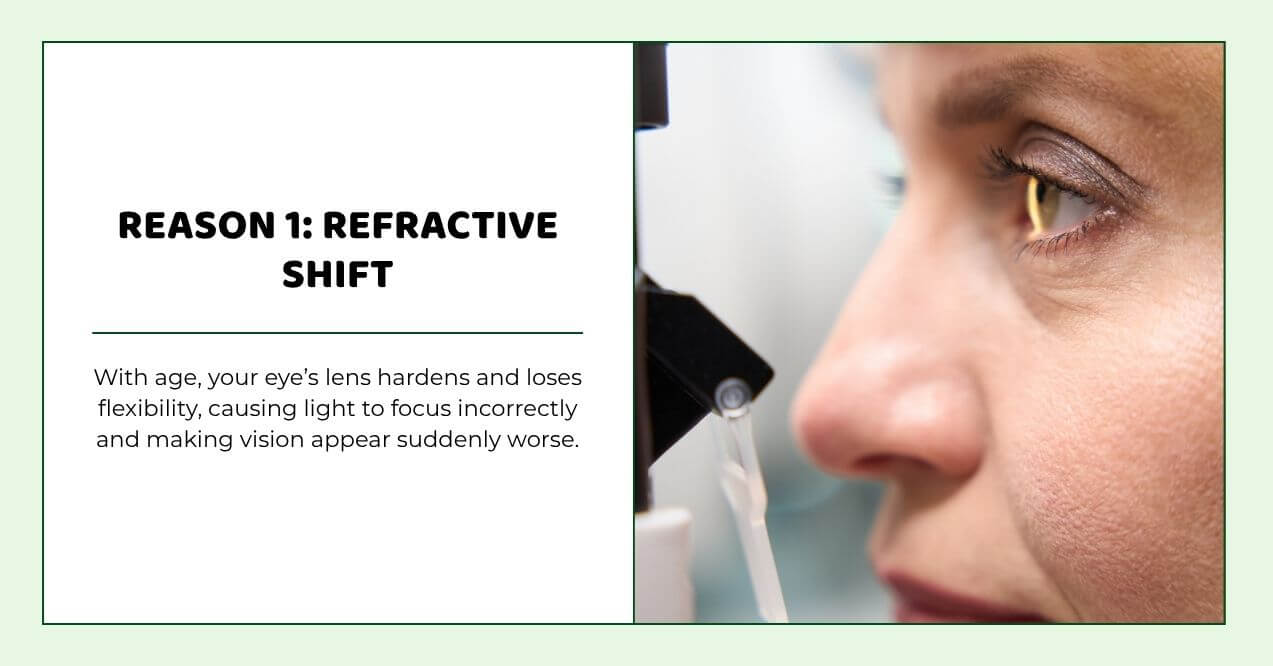
Your eye’s lens naturally hardens as years pass. This stiffening reduces its ability to change shape quickly. When the lens can’t adjust easily, light doesn’t focus correctly.
Lens stiffness reduces adaptive focus range. You may notice blur when switching between near and far objects. Reading becomes harder, or distant signs appear less sharp.
Slower pupil reflex causes light adaptation delay. Your pupils take longer to adjust to brightness changes. Moving from dark to bright spaces creates temporary blur.
Shifting curvature causes new blur zones. The cornea’s curve may change slightly over time. Even small shifts create spots where vision seems off.
Many people feel their vision is “suddenly wrong” despite gradual changes. This happens because the brain compensates until it can’t anymore. Then you notice the accumulated shift all at once — and begin to wonder, does wearing glasses make your eyesight worse? Glasses don’t weaken your vision; they simply help correct focus while your eyes continue to change naturally over time.
Reason 2: Excess Screen Use
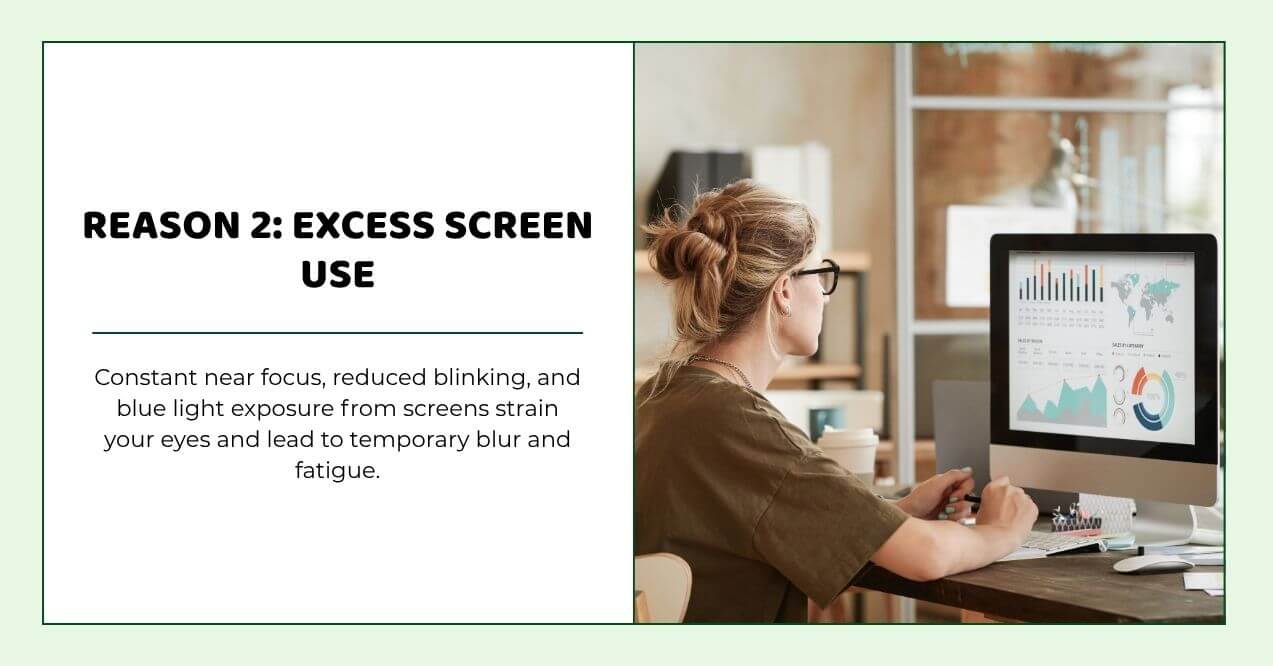
Modern devices demand constant near focus from your eyes. Phones and laptops sit closer than traditional reading materials, making your eye muscles work harder and fatigue faster. Prolonged close focus fatigues eye muscles quickly – that causes temporary blur and discomfort.
You also blink about 60% less when using screens, reducing lubrication and causing dryness or irritation. Blue light adds further strain and glare, forcing your eyes to work harder to stay focused.
Common digital eye strain factors include:
- Prolonged near focus and reduced eye muscle flexibility
- Decreased blink rate and tear film instability
- Continuous blue light exposure and glare
- Poor screen distance or harsh lighting conditions
Taking micro-breaks helps reset your focusing system naturally. The 20-20-20 rule works well — every 20 minutes, look at something 20 feet away for 20 seconds. Proper screen distance also matters: position your monitor at arm’s length and slightly below eye level, and use warm lighting to reduce harsh contrasts.
Practicing eye exercises to improve vision — such as focus-shifting and blinking routines — may also relieve digital eye strain and help your eyes recover from daily fatigue.
Reason 3: Inadequate Nutrient Support
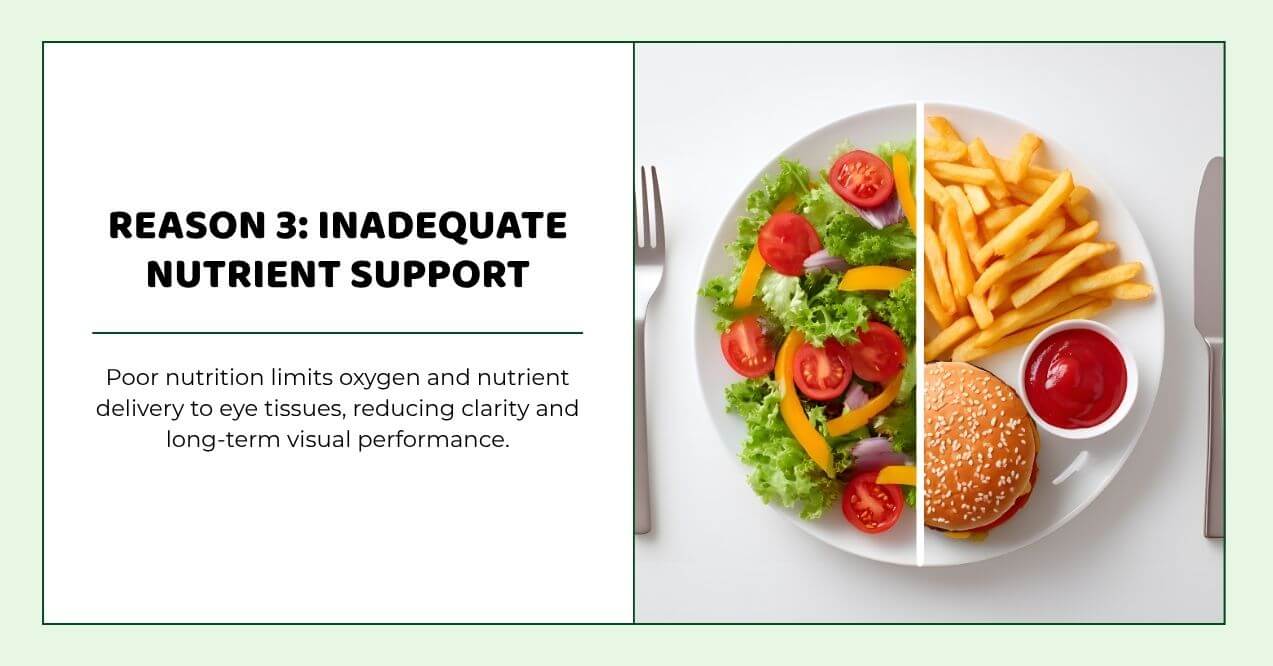
Small blood vessels throughout your eyes deliver oxygen and nutrients constantly. These vessels feed the retina, lens, and optic nerve tissues. Without adequate nutrition, these tissues may struggle to maintain clarity.
Key nutrients that may help your eyes:
- Antioxidants – potentially help protect optic tissues against cell damage
- Healthy fats – maintain nerve insulation and tear production quality
- Carotenoids like lutein – may promote retinal filtering strength over time
A varied diet rich in vegetables, fish, and nuts provides essential compounds. Dark leafy greens offer lutein and zeaxanthin readily. Fatty fish deliver omega-3s that aid circulation.
Some people find dietary approaches that support cognitive function may also benefit eye health. Both systems rely on healthy circulation and nutrient delivery. Consider how your overall nutrition affects multiple body systems simultaneously.
Certain foods may work against eye health when consumed excessively. Highly processed options often lack the nutrients your eyes need. Foods that potentially affect memory might influence vision through similar inflammatory pathways.
Reason 4: Genetic Factors
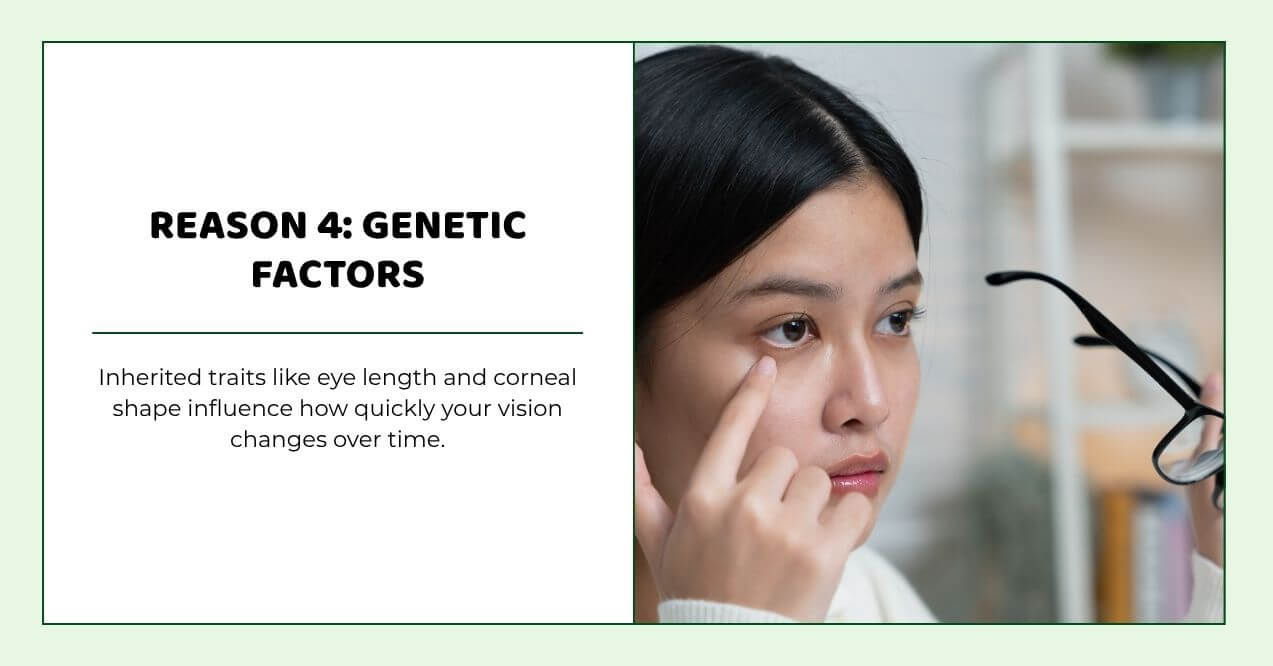
Some structural traits naturally pass down through families. Eye length, corneal curvature, and tissue composition vary genetically — setting a baseline for how your vision may change over time.
Inherited factors that influence eyesight include:
- Eye length: Longer or shorter eyeballs alter how light focuses inside the eye, affecting whether vision tends toward nearsightedness or farsightedness.
- Corneal steepness: A steeper or flatter cornea changes how light bends as it enters, impacting image sharpness.
- Connective tissue composition: Structural proteins determine how well your eye maintains its shape with age.
These are not diseases but natural structural characteristics you’re born with. Lifestyle, environment, and nutrition still play major roles — your genetics simply influence how quickly or slowly changes occur.
Reason 5: Tear Film & Surface Instability
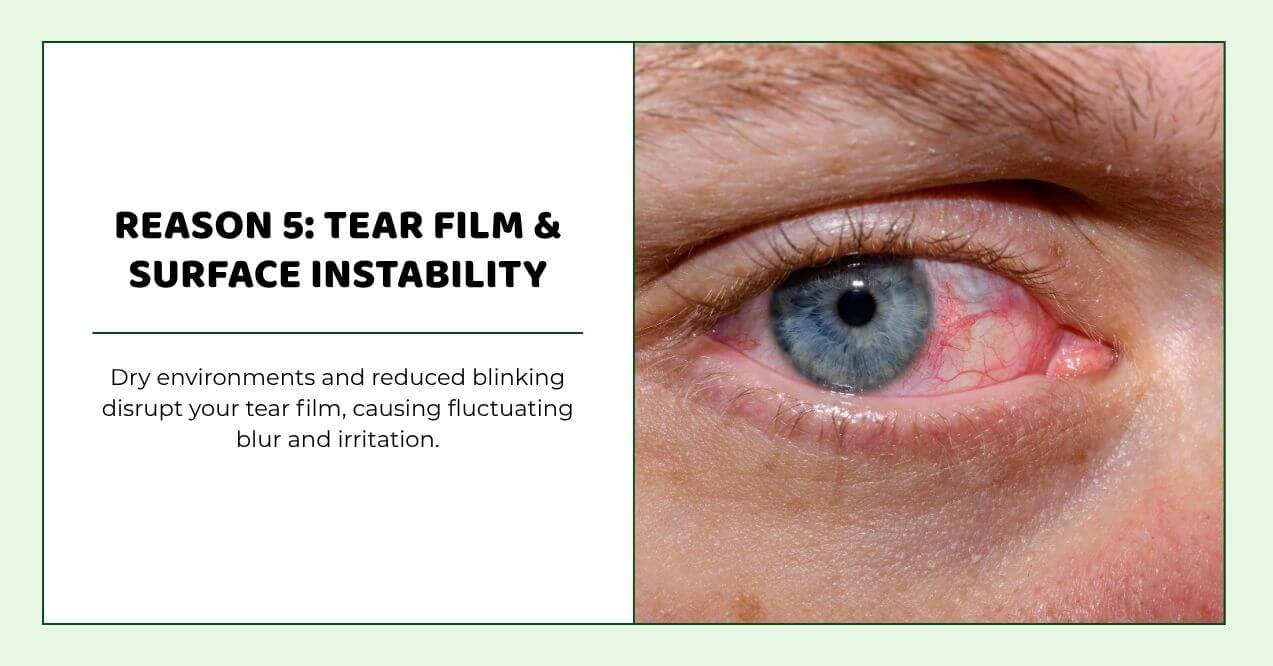
A stable tear film constantly coats the surface of your eyes, smoothing light entry and protecting delicate tissues. Unstable tear layers cause patchy vision that comes and goes. You might see clearly one moment and blurry the next. This inconsistency often worsens during extended focus periods.
Key contributors to tear instability include:
- Dry indoor air: Heating and air conditioning reduce humidity, increasing tear evaporation.
- Reduced blinking: Screen use and intense concentration cause fewer blinks, letting tears dry faster.
- Environmental factors: Wind, smoke, and low moisture levels worsen dryness and irritation.
This type of vision change is usually temporary and environment-related. Supporting tear stability through hydration, humidifiers, and visual breaks often helps relieve the feeling that why is my eyesight getting worse during screen-heavy or dry conditions.
Reason 6: Metabolic Stress
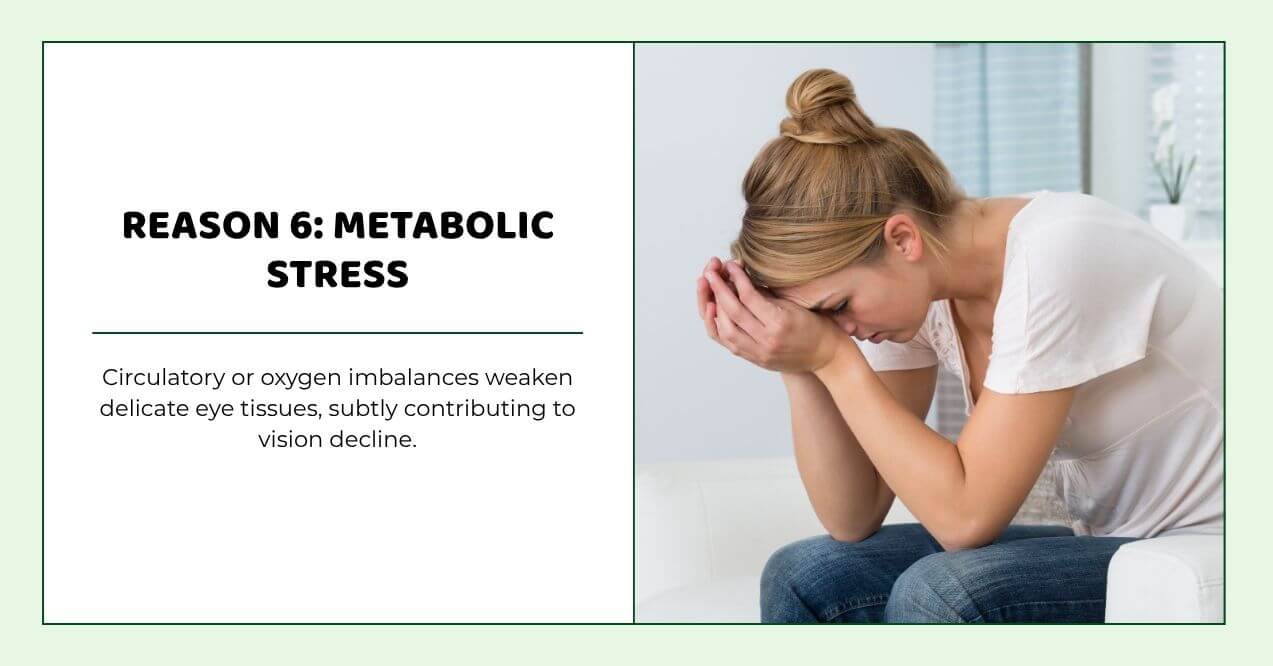
Your eyes depend on consistent blood flow and oxygen delivery. Internal body stress may affect these delicate supply systems. Vascular tension or circulation changes impact eye function over time.
How internal stress affects your vision:
- Microvessel stress – potentially reduces nutrient delivery to retinal tissues
- Oxygen fluctuation – affects retinal performance in subtle ways
- Cell wear – gradually impacts structural strength throughout your eyes
Your retina uses more oxygen per gram than most body tissues. Even small changes in oxygen levels potentially influence visual processing. Daily cellular processes create reactive molecules naturally.
Body-wide balance directly influences local eye performance in multiple ways. What affects your overall circulation potentially affects your vision too. Managing general metabolic health helps maintain eye function naturally.
Supplements & Nutritional Support
Eyes facing daily strain and age-related changes need consistent nutrient intake. Targeted supplementation may help fill gaps your diet doesn’t cover completely. Combining multiple beneficial compounds potentially offers broader benefits than single nutrients alone.
SightMax vision supplement contains a carefully selected blend of antioxidants, plant extracts, and essential nutrients. Its formula includes carotenoids that concentrate in retinal tissue naturally. Vitamins and herbal extracts in the blend may help protect delicate eye structures from cell damage.
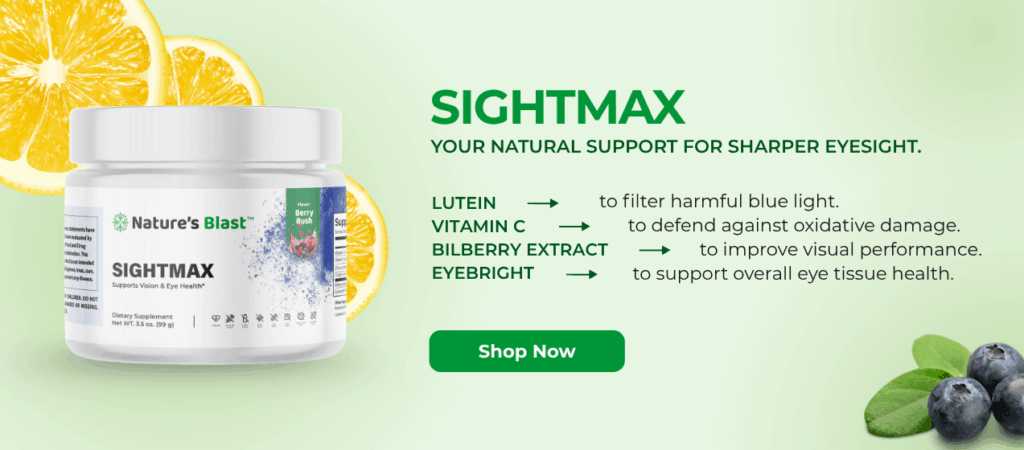
What this supplement provides:
- Carotenoids that may concentrate in retinal tissue
- Vitamins that potentially protect delicate eye structures
- Plant compounds working alongside essential minerals
- Ingredients that may help maintain comfort during screen use
The supplement’s ingredients potentially aid healthy circulation to eye tissues. Better blood flow may improve nutrient delivery throughout the visual system. This approach addresses multiple factors affecting vision clarity simultaneously.
SightMax works best as part of a complete vision care routine. Balanced nutrition, regular screen breaks, and proper lighting remain essential. Supplements complement but don’t replace these foundational habits for eye health.
When to Seek Professional Evaluation
Certain vision changes need prompt professional attention regardless of age. Sudden shifts in clarity within days or hours warrant immediate evaluation. Gradual changes over months follow different patterns than acute problems.
Watch for these warning signs:
- Shadows, flickers, or floating spots appearing suddenly
- Persistent blur not improving with updated prescriptions
- Asymmetry between eyes developing over time
- Persistent discomfort accompanying vision changes
- New patterns of light flashes
Visual disturbances may indicate structural changes requiring professional care. Some causes require specific interventions beyond corrective lenses alone. Pain, pressure, or lasting irritation alongside blur needs thorough examination.
Monitor your own vision trends between professional examinations regularly. Note when changes occur and what activities precede them. This information helps professionals identify patterns and causes more quickly.
Practical Habits to Support Eye Health
Simple daily habits may help maintain visual clarity longer. These practices address the six reasons discussed above directly. Consistency matters more than perfection with these supportive strategies.
- 20-20-20 breaks rest your focusing system naturally.
Every 20 minutes, look at something 20 feet away for 20 seconds. This micro-rest helps counter the fatigue from excess screen use.
- Proper lighting reduces glare and dim extremes throughout your day.
Position lights to avoid screen reflections and harsh shadows. Good lighting supports comfortable focus and reduces metabolic strain.
- Blink reminders help maintain a stable tear film during concentration.
Set periodic alerts to blink deliberately several times. This simple act addresses tear film instability directly.
Each habit connects to specific causes of vision changes mentioned earlier. Screen breaks combat digital fatigue while varied nutrition supports cellular function. Combined consistently, these practices may help slow age-related decline.
Conclusion
Six key factors potentially explain gradual vision decline over time. Structural drift, digital fatigue, nutrient availability, heredity, tear stability, and systemic strain all play roles. Each affects your eyes through different mechanisms and timelines.
Some decline represents expected aging that everyone experiences eventually. However, supportive habits and consistent monitoring may maintain clarity longer. Small daily choices accumulate into meaningful differences over years.
Understanding these six reasons why is my eyesight getting worse helps you make informed decisions about eye care. You can address modifiable factors while accepting natural changes gracefully. Regular professional evaluation combined with daily supportive practices offers the best approach.
You can’t stop age-related changes completely, but healthy habits may slow decline. Regular breaks from screens, diverse nutrition, and proper lighting help. Consistent professional monitoring catches issues early when interventions work best.
Rapid vision loss needs immediate professional evaluation to identify causes. Sudden changes differ from gradual decline and may need specific interventions. Multiple factors sometimes combine to accelerate sight deterioration beyond normal aging patterns.
Sudden blur appearing within hours or days needs prompt attention. Vision changes accompanied by pain, flashes, or floating spots require evaluation. Asymmetric changes where one eye worsens faster than the other also warrant professional assessment.
FAQ
References


